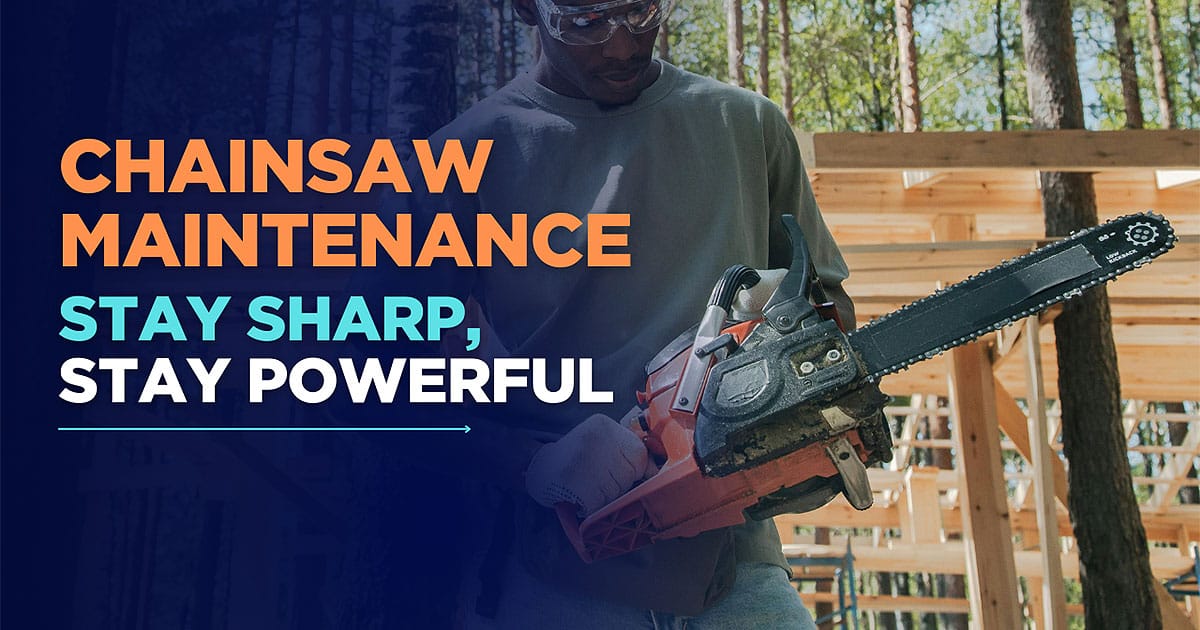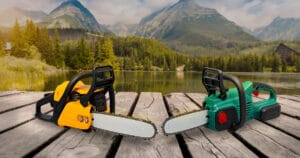Taking care of your chainsaw through proper chainsaw maintenance keeps it safe and working well. About 36,000 people get hurt by chainsaws each year. Regular chainsaw maintenance can prevent accidents and keep your saw in good shape. Simple jobs like tightening the chain or cleaning the air filter help a lot. Your chainsaw will work better and last longer too. Don’t wait for issues—small care through chainsaw maintenance makes a big difference!
Table of Contents
Key Takeaways
- Taking care of your chainsaw stops accidents and makes it last longer. Easy jobs like cleaning and checking parts help a lot.
- Always wear safety gear like gloves and goggles to protect yourself when using or fixing your chainsaw.
- Clean your chainsaw often by washing the chain, guide bar, and powerhead. A well-maintained chainsaw performs more efficiently and has a longer lifespan.
- Sharpen the chain often to cut well and avoid kickbacks. A sharp chain is safer and easier to handle.
- Stick to a maintenance plan with daily, weekly, and monthly tasks. This keeps your chainsaw working well and saves money on repairs.
Safety Precautions
Chainsaw maintenance is not just about keeping it working. It’s also about staying safe while using it. Chainsaws are strong tools, so safety steps can stop injuries. These steps also make your maintenance easier. Let’s look at the basics you should know.
Essential Safety Gear
Before using your chainsaw, wear the right safety gear. This gear can protect you from getting hurt.
- Protective Gloves: These keep your hands safe from cuts. They also help you hold the chainsaw better.
- Safety Goggles: Small flying bits can hurt your eyes. Goggles protect them while you clean or fix your chainsaw.
- Ear Protection: Chainsaws are very loud. Wear earplugs or earmuffs to protect your hearing.
- Steel-Toed Boots: These boots protect your feet and stop slipping on wet ground.
- Chainsaw Chaps: If the chain hits your legs, these can stop it quickly.
Pro Tip: Use thick gloves that resist cuts. Gear that reduces vibration makes work safer and easier.
Pre-Maintenance Checks
Check your chainsaw before starting any maintenance. A quick look can stop accidents later.
Turn off and unplug the chainsaw
Always turn off your chainsaw first. Unplug it if it’s electric. For gas chainsaws, take out the spark plug. This stops it from starting by accident.
Remove the spark plug for added safety
Taking out the spark plug makes it even safer. It also helps you move the chain by hand during checks.
Inspect for visible damage or loose components
Look at your chainsaw for any problems. Check for cracks, loose screws, or worn parts. Focus on the chain and guide bar. Fix anything wrong before moving on.
Did You Know? Checking your chainsaw often can stop common problems. You can catch things like fuel leaks or bad spark plugs early. This helps you fix small issues before they get worse.
By following these safety tips, you’ll stay safe and make chainsaw maintenance easier.
Cleaning the Chainsaw
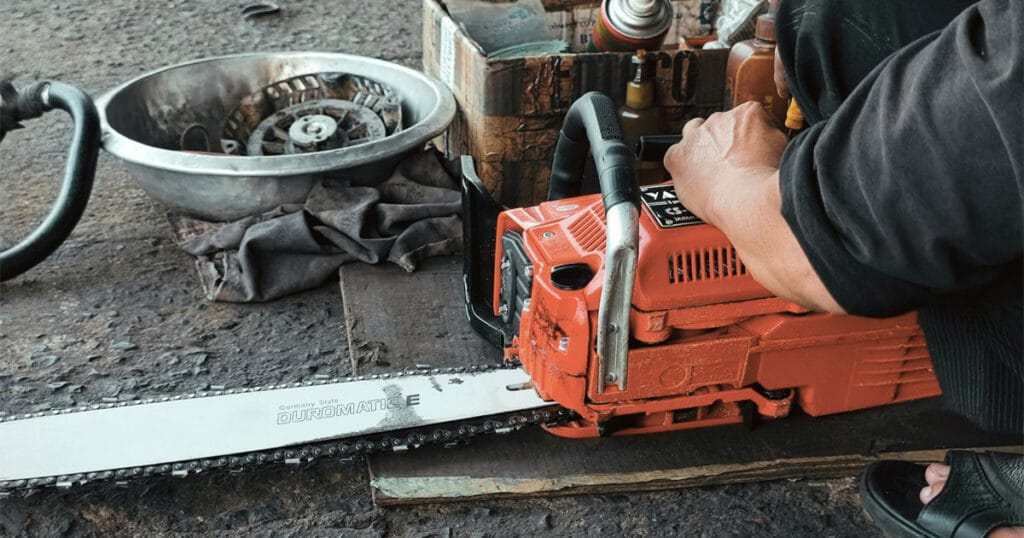
Keeping your chainsaw clean is a vital part of chainsaw maintenance. A clean chainsaw performs better, lasts longer, and is safer to use. Dirt, sawdust, and oil buildup can cause blockages, reduce efficiency, and wear down essential components. Let’s dive into how you can clean your chainsaw step by step.
Cleaning the Chain
The chain is the heart of your chainsaw, and keeping it clean ensures smooth operation.
Remove the chain and soak it in a cleaning solution
Start by carefully removing the chain. Place it in a container filled with a cleaning solution, like a mix of warm water and mild detergent. Let it soak for about 15–20 minutes to loosen the grime.
Scrub the chain with a brush to remove debris
After soaking, use a stiff brush to scrub away any remaining debris. Pay attention to the links and teeth. Once clean, rinse the chain thoroughly and dry it completely to prevent rust.
Tip: Regular cleaning prevents blockages in oil passages, ensuring proper lubrication and reducing wear on your chainsaw.
Cleaning the Guide Bar
The guide bar directs the chain, so keeping it clean is essential for precision and safety.
Remove dirt and sawdust from the guide bar groove
Use a flat tool or a small brush to clear out dirt and sawdust from the groove. This step prevents debris from obstructing the chain’s movement.
Inspect for wear and tear
Check the guide bar for any signs of wear, like uneven edges or cracks. Replace it if necessary to avoid further damage.
Did You Know? Cleaning debris from the guide bar reduces strain on the motor and enhances your chainsaw’s effectiveness.
Cleaning the Powerhead
The powerhead houses the engine and other critical components. Keeping it clean ensures your chainsaw runs efficiently.
Use compressed air to clean the powerhead
Blow out dust and sawdust from the powerhead using compressed air. Focus on vents and crevices where debris tends to accumulate.
Wipe down the exterior with a damp cloth
Finish by wiping the exterior with a damp cloth to remove any remaining dirt or oil.
Pro Tip: Regular cleaning of the powerhead prevents unnecessary wear and tear, helping your chainsaw last longer.
By following these steps, you’ll keep your chainsaw in top shape and ready for action.
Chainsaw Maintenance Essentials
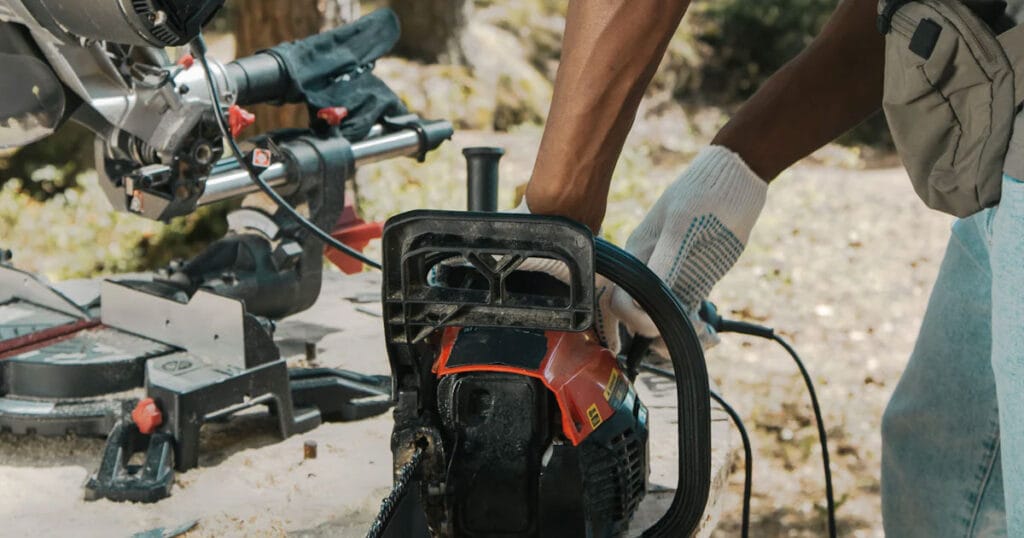
Chainsaw maintenance is more than just cleaning—it’s about keeping your tool sharp, efficient, and safe to use. Regular upkeep ensures your chainsaw performs at its best and lasts longer. Let’s explore three essential chainsaw maintenance tasks you should never skip.
Chain Sharpening
A dull chain makes cutting harder and less safe. Sharpening your chain regularly keeps your chainsaw running smoothly and reduces strain on the motor.
Use a file guide to sharpen the chain teeth
Grab a file guide to sharpen the chain teeth evenly. This tool helps you maintain the correct angle, ensuring each tooth cuts efficiently. Work on one tooth at a time, and don’t rush—precision matters here.
Adjust depth gauges as needed
Depth gauges control how deeply the teeth cut into the wood. If they’re too high, the chain won’t cut well. Too low, and it could grab too much wood, causing kickback. Use a depth gauge tool to adjust them to the recommended height.
Pro Tip: A sharp chain not only improves cutting efficiency but also reduces the risk of accidents caused by uneven cuts or excessive vibrations.
Air Filter Cleaning
Your chainsaw’s air filter keeps the engine running smoothly by blocking dirt and debris. A clogged filter can reduce performance and even damage the engine.
Remove and clean the air filter with soap and water
Take off the top cover to access the air filter. Use a soft brush to remove loose dirt, then wash the filter with warm, soapy water. Rinse well and allow it to dry fully before reinstalling.
Replace if too dirty or damaged
If the filter looks too worn or doesn’t come clean, replace it. A fresh filter ensures your chainsaw gets the airflow it needs for optimal performance.
Did You Know? Cleaning or replacing the air filter regularly can prevent engine strain and extend the life of your chainsaw.
Chain Tension Adjustment
Maintaining the correct chain tension is essential for safe and efficient operation. A loose chain can slip off, while an overly tight chain can cause unnecessary wear.
Loosen the bar nuts and adjust the tension screw
Start by loosening the bar nuts slightly. Use the tension screw to adjust the chain until it’s snug against the guide bar but still moves freely when pulled by hand.
Ensure the chain is snug but moves freely
Ensure correct tension by pulling the chain free from the guide bar. It should snap back into place without sagging. Make adjustments as necessary to maintain the ideal balance.
Quick Tip: Regularly checking and adjusting chain tension prevents kickbacks and ensures smoother cutting.
By staying on top of these chainsaw maintenance tasks, you’ll enjoy a safer, more efficient chainsaw that lasts for years. Chainsaw maintenance doesn’t have to be complicated—just a few simple steps can make all the difference.
Lubrication
Lubrication is key to keeping your chainsaw working well. Without it, the chain and guide bar wear out fast. This leads to bad performance and expensive fixes. Here’s how to keep your chainsaw properly lubricated.
Check and refill the oil reservoir
Always check the oil level before using your chainsaw. Many chainsaws have a clear window or dipstick to show the oil level. If it’s low, add the right bar and chain oil recommended by the maker. Your chainsaw relies on the right oil—using the wrong kind risks costly repairs.
Pour the oil slowly to avoid spilling. Don’t overfill, as it can cause leaks. Clean the oil passages often to keep the oil flowing. This helps the chain move smoothly and prevents blockages.
Tip: Use good-quality oil. It lowers friction, reduces wear, and helps your chainsaw last longer.
Ensure proper lubrication during use
Watch your chainsaw while you use it. A well-lubricated chain should glide easily on the guide bar. If you see smoke or the chain feels dry, stop and check the oil level. Running without enough oil can badly damage the chain and guide bar.
To test the lubrication system, hold the chainsaw over a clean surface and rev the engine. You should see a thin oil spray. If not, clean the oil passages or check the manual for help.
- Why lubrication matters:
- It reduces wear on the chain and guide bar.
- It makes cutting smoother and easier.
- It helps your chainsaw last longer.
Keeping your chainsaw lubricated improves its performance and saves repair costs. This simple step makes a big difference over time.
Troubleshooting Common Chainsaw Problems
Even with care, chainsaws can still have issues. Knowing how to fix them saves time and effort. Let’s examine three common challenges and their practical solutions.
Dull Chains
A dull chain slows work and can be unsafe. Spotting the signs early helps prevent accidents.
Look for uneven cuts or extra sawdust
Does your chainsaw leave rough cuts or make too much sawdust? These are signs the chain is dull. You might also feel the saw struggling to cut, needing more pressure.
- Dull chains make cutting harder and less efficient.
- The extra effort can tire you out, increasing accident risks.
- Pushing harder on the saw can cause dangerous kickbacks.
Sharpen or change the chain
Use a file guide to sharpen the chain teeth. This tool helps keep the right angle for each tooth. If sharpening doesn’t work, replace the chain. A sharp chain cuts better and keeps you safer.
Fuel Leaks
Fuel leaks are messy and can harm your chainsaw. Fixing them quickly avoids bigger problems.
Check fuel lines and tank for damage
Look at the fuel lines and tank for cracks or loose parts. These often cause leaks. If you find damage, don’t ignore it.
Replace broken parts
Swap out damaged parts with ones from the maker. Regular checks can catch leaks early and save money on repairs.
Bad Spark Plugs
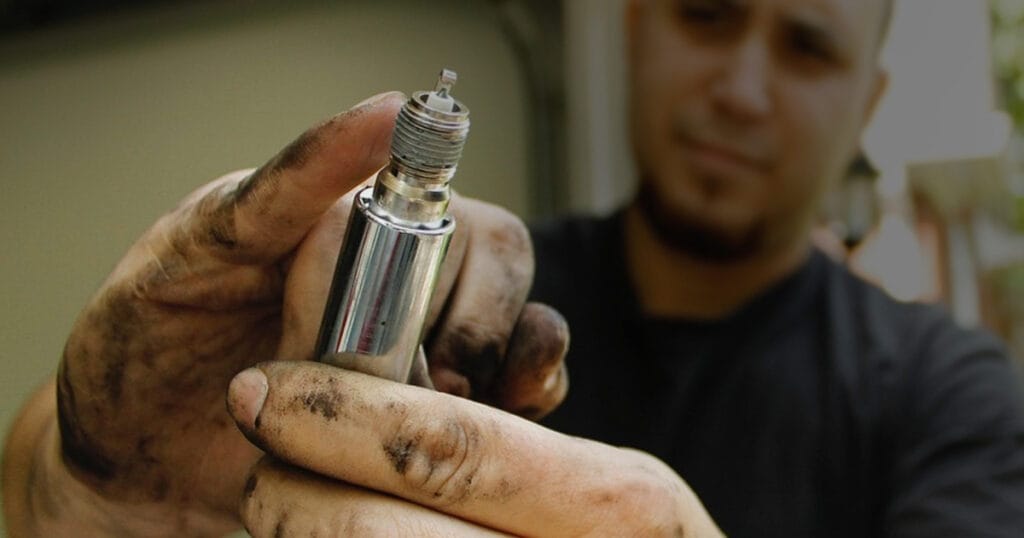
Spark plugs help start your chainsaw. If they fail, the chainsaw won’t work well.
Take out and check the spark plug
Remove the spark plug and look for cracks or dirt. A worn or dirty spark plug makes starting harder and lowers performance.
Clean or replace if needed
Clean a dirty spark plug with a wire brush. If it’s broken, get a new one. Checking spark plugs often helps your chainsaw start easily and last longer. It also avoids breakdowns and saves fuel.
By fixing these problems, your chainsaw will work better and last longer. Troubleshooting is simple and keeps your chainsaw ready to use.
Chainsaw Maintenance Schedule
A good chainsaw maintenance schedule keeps your tool in top shape and prevents costly repairs. By sticking to a routine, you’ll ensure your chainsaw runs smoothly and lasts longer. Whether you’re a weekend warrior or a daily user, following these simple tasks can save you time and effort in the long run. Let’s break it down into daily, weekly, and monthly steps.
Daily Tasks
Clean the chain and guide bar after each use
After every session, take a few minutes to clean the chain and guide bar. Remove sawdust, dirt, and oil buildup to keep everything running smoothly. A clean chain reduces wear and ensures precise cuts.
Check chain tension and lubrication
Before storing your chainsaw, check the chain tension. It should be snug but still move freely. Also, verify the oil reservoir is full to keep the chain properly lubricated during your next use.
Tip: Inspect the bar daily for wear and ensure the chain brake works correctly. These small checks can prevent bigger problems later.
Weekly Tasks
Inspect and clean the air filter
Take out the air filter and clean it with warm, soapy water. Let it dry completely before putting it back. If it’s too dirty or damaged, replace it. A clean air filter keeps the engine running efficiently.
Tighten loose screws or bolts
Chainsaws vibrate a lot during use, which can loosen screws and bolts. Check all controls, bolts, and handles weekly to ensure everything is secure. This step keeps your chainsaw safe to operate.
Monthly Tasks
Perform a thorough cleaning of the chainsaw
Once a month, give your chainsaw a deep clean. Remove debris from the chain, guide bar, and powerhead. Use compressed air to clean hard-to-reach areas. Regular cleaning prevents long-term damage and keeps your chainsaw performing at its best.
Inspect all components for wear and tear
Take time to inspect the spark plug, sprockets, and bearings. Replace worn parts to avoid unexpected breakdowns. Also, check the fuel filter and change it if needed. Draining the fuel completely before storing your chainsaw for over 30 days can prevent clogs and damage.
Did You Know? Monthly maintenance, like cleaning and inspecting components, enhances performance and ensures user safety.
By following this schedule, you’ll keep your chainsaw in excellent condition. A little effort now saves you from bigger headaches later.
Final Verdict
Taking care of your chainsaw is easy with simple steps. Clean, sharpen, and fix problems to keep it working well. Regular chainsaw maintenance helps your chainsaw last longer and work better. Did you know that over 27% of chains fail because of poor care? A little effort can save you money on repairs.
Follow the daily, weekly, and monthly tasks shared here. These steps are quick but very helpful. A cared-for chainsaw is safer, lasts longer, and cuts better. Start your maintenance routine now—you’ll be glad you did!
FAQ
How often should I sharpen my chainsaw chain?
You should sharpen your chainsaw chain after every few uses or when you notice uneven cuts or excessive sawdust. Regular sharpening keeps your chainsaw efficient and safe to use.
What type of oil should I use for lubrication?
Always use the bar and chain oil recommended by your chainsaw’s manufacturer. This oil reduces friction and prevents wear. Avoid using motor oil or other substitutes, as they can damage your chainsaw.
Why is my chainsaw not starting?
Check the spark plug, fuel level, and air filter. A dirty air filter or a faulty spark plug often causes starting issues. Clean or replace these components to get your chainsaw running again.
How do I know if my chain tension is correct?
Pull the chain slightly away from the guide bar. It should snap back into place without sagging. If it’s too loose or too tight, adjust the tension screw until it moves freely but stays snug.
Can I store my chainsaw with fuel in it?
No, it’s best to drain the fuel if you won’t use your chainsaw for over 30 days. Storing it with fuel can cause clogs and damage the engine. Always clean and dry it before long-term storage.

